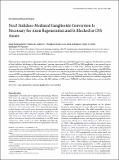Neu3 sialidase-mediated ganglioside conversion is necessary for axon regeneration and is blocked in CNS axons
Abstract
PNS axons have a high intrinsic regenerative ability, whereas most CNS axons show little regenerative response. We show that activation of Neu3 sialidase, also known as Neuraminidase-3, causing conversion of GD1a and GT1b to GM1 ganglioside, is an essential step in regeneration occurring in PNS (sensory) but not CNS (retinal) axons in adult rat. In PNS axons, axotomy activates Neu3 sialidase, increasing the ratio of GM1/GD1a and GM1/GT1b gangliosides immediately after injury in vitro and in vivo. No change in the GM1/GD1a ratio after axotomy was observed in retinal axons (in vitro and in vivo), despite the presence of Neu3 sialidase. Externally applied sialidase converted GD1a ganglioside to GM1 and rescued axon regeneration in CNS axons and in PNS axons after Neu3 sialidase blockade. Neu3 sialidase activation in DRGs is initiated by an influx of extracellular calcium, activating P38MAPK and then Neu3 sialidase. Ganglioside conversion by Neu3 sialidase further activates the ERK pathway. In CNS axons, P38MAPK and Neu3 sialidase were not activated by axotomy.
Citation
Kappagantula , S , Andrews , M R , Cheah , M , Abad-Rodriguez , J , Dotti , C G & Fawcett , J W 2014 , ' Neu3 sialidase-mediated ganglioside conversion is necessary for axon regeneration and is blocked in CNS axons ' , The Journal of Neuroscience , vol. 34 , no. 7 , pp. 2477-2492 . https://doi.org/10.1523/JNEUROSCI.4432-13.2014
Publication
The Journal of Neuroscience
Status
Peer reviewed
ISSN
0270-6474Type
Journal article
Description
This work was supported by the Medical Research Council, the Christopher and Dana Reeve Foundation, the John and Lucille van Geest Foundation, the Henry Smith Charity, the Commonwealth and Overseas scholarships, and the Hinduja Cambridge Trust.Collections
Items in the St Andrews Research Repository are protected by copyright, with all rights reserved, unless otherwise indicated.

